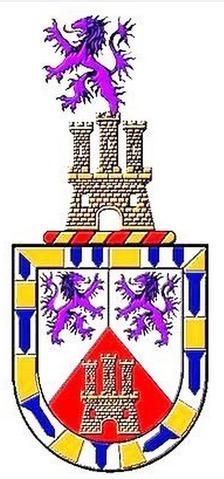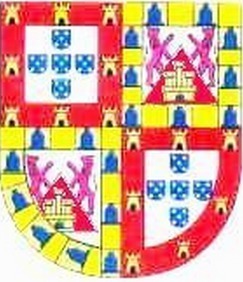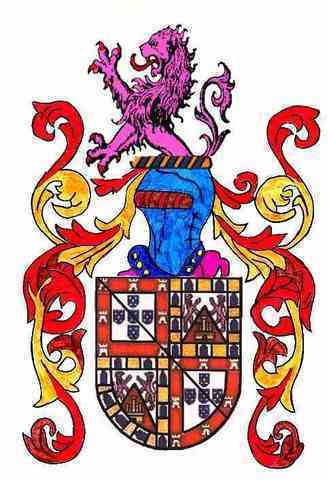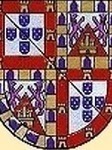Family Tree of Carlos Spartacus. » Count Alfonso / Afonso Enríquez / Henriques Count of Gijón and Noreña (asturias) (Count Alfonso / Afonso Enríquez / Henriques, Count of Gijón and Noreña (asturias)) Enríquez de Castilla (1355-1395)
Données personnelles Count Alfonso / Afonso Enríquez / Henriques Count of Gijón and Noreña (asturias) (Count Alfonso / Afonso Enríquez / Henriques, Count of Gijón and Noreña (asturias)) Enríquez de Castilla
Les sources 1, 2- Prénom Count Alfonso / Afonso Enríquez / Henriques, Count of Gijón and Noreña (asturias).
- Il est né en l'an 1355 dans Gijón, Astúrias, España.
- Profession: Conde de Gijon y Norona, Conde de Gijon e de Noronha, Conde de Gijón y Noronha, Conde de Gijón y de Noroña (Noreña), Conde de Noronha e de Gijon..
- Il est décédé le 27 août 1395 dans Marans, Poitou-Charentes, France, il avait 40 ans.
- Il est enterré le 27 août 1395 dans Marans, Charene-Maritime, França.
- Un enfant de King Enrique II ( Henri II ) "the fratricidal" King of Castile (Trastámara) et Mistress Elvira Iñiguez de La Vega
Famille de Count Alfonso / Afonso Enríquez / Henriques Count of Gijón and Noreña (asturias) (Count Alfonso / Afonso Enríquez / Henriques, Count of Gijón and Noreña (asturias)) Enríquez de Castilla
(1) Il est marié avec Infanta Isabel / Isabella "Dama de Viseu" de Noreña de Portugal.
Ils se sont mariés environ 1378 à Burgos, Castela, Espanha.
Cônjuge: Alfonso Enríquez, conde de Gijón y Noreña
Enfant(s):
- Constança / Constance of Noronha de Noronha ± 1395-1480
(2) Il est marié avec Inés de Soto dos Miranda de Asturias.
Ils se sont mariés
Enfant(s):
(3) Il est marié avec unknown mistress.
Ils se sont mariés
Enfant(s):
Notes par Count Alfonso / Afonso Enríquez / Henriques Count of Gijón and Noreña (asturias) (Count Alfonso / Afonso Enríquez / Henriques, Count of Gijón and Noreña (asturias)) Enríquez de Castilla
Alfonso Enríquez (Gijón, 1355 – Marans or Portugal, c. 1400),[1] Count of Noreña and of Gijón and lord of several places, was the eldest son of King Henry II of Castile and Elvira Íñiguez born before the king's marriage.[2][a] As one of the most powerful feudal lords in Asturias, where he owned many properties, he attempted to declare the independence of this region from his brother King John I and then from his nephew, King Henry III of Castile. He and his Portuguese wife, Isabel of Portugal, a natural daughter of King Ferdinand I, are the ancestors of the Noronha lineage in Portugal.
Contents [hide]
1Early years
2Uprisings against his brother John I and nephew Henry III of Castile
3Final years
4Marriage and issue
5Notes
6References
7Bibliography
Early years[edit]
Alfonso was raised close to his father during his youth. A year before his reign as king of Castile and León, Henry II gave Alfonso the lordship of Noreña and as such he appears confirming a charter in November 1368. He was knighted by his father in Santiago de Compostela in the spring of 1372 and it was probably at that time that he received the titles of Count of Noreña and of Gijón.[6][b] He also received the properties that his father had inherited from his godfather and tutor, Rodrigo Álvarez, in León.[9] In Asturias, these included the strategic counties of Noreña and Gijón plus Ribadesella, Villaviciosa, Nava, Laviana, Cudillero, Luarca, and Pravia. In León, he also owned the two Babias and Argüellos, both territories on the border with Asturias thanks to which he was able to move from one region to another without having to abandon his domains.
His first military experience was during the second Fernandine war in 1372 – 1373 where he succeeded in quashing the rebellions in Viana do Bolo and Cascais. The war came to an end with the signing of the Treaty of Santarém on 19 March 1373. One of the stipulations of the treaty was the marriage of Alfonso Enríquez with Isabel of Portugal,[10] a natural daughter of King Ferdinand I, who at that time was about nine years old.
Uprisings against his brother John I and nephew Henry III of Castile[edit]
Alfonso's father, King Henry II, died in May 1379 and was succeeded by his first-born son who reigned as John I of Castile. In the spring of 1381, King John I was preparing to go to war with Portugal. His half-brother, Alfonso Enríquez, knowing that all the soldiers from Asturias were away from the region, offered England, an ally of Portugal, the harbor of Gijón. Upon hearing this, King John I imprisoned his brother and confiscated his properties. Alfonso was only able to recover his territories in Asturias and León, including the County of Noreña, thanks to the intervention of the Bishop of Oviedo and after paying homage to his brother in Oviedo Cathedral.[11][12]
The Count of Noreña, however, prepared a new uprising. His brother, King John, entrusted him with a diplomatic mission for negotiations with Portugal and, in early 1382, Alfonso, with his brother's permission, went to Braganza but, instead of defending Castile, he hid his intentions and tried to secure England's support for Portugal.[13] The Castilian monarch in reprisal confiscated Alfonso's properties in Asturias and in the mountains of León.
In 1383, King John I discovered that his brother Alfonso had entered into new agreements with the King of Portugal. The king rushed to Asturias and subdued the entire region except for the port city of Gijón where his rebellious brother had sought refuge. At the end, the King forgave his brother on 18 July 1383 after having imprisoned him in La Puebla de Montalban under the custody of Pedro Tenorio, the archbishop of Toledo.[14]
In September of that year, after the Courts of Segovia, the King donated all of Count Alfonso's properties in Asturias to Gutierre de Toledo, bishop of Oviedo, including the county of Noreña.[15][16][17] As compensation, King John I granted Alfonso the title of Count of Valencia de Don Juan, a territory that was more accessible and controllable. The King also granted his son Henry the title of Prince of Asturias, with all the lordships thereby linking this difficult to reach territory — the ideal setting for conspiracies and uprisings due to its isolation and terrain — to the crown.
Shortly afterwards, following the death of King Ferdinand I in October 1383, King John I decided to imprison Alfonso in the castle of Almonacid since, having married a daughter of the deceased king, albeit illegitimate, Alfonso was a rival and could undermine his rights to the crown of Portugal as the husband of Beatrice, the late king's daughter with Leonor Teles. In July 1386, John I confiscated all of Alfonso's properties.[18] His imprisonment lasted eight years and only after the death of King John I in 1390 was it possible for Alfonso to regain his freedom and his possessions.[19]
During the reign of his nephew, Henry III of Castile, Alfonso continued to rebel against the crown. In 1394 the King laid siege to the city of Gijón. Isabel defended the city but finally surrendered. The King returned her son Henry who had been held hostage and ordered her to leave the kingdom and join her husband, Count Alfonso, who was in France at that time.[20]
Final years[edit]
Little is known about his final years except that he was made prisoner by order of the King in Saint-Jean-de-Luz but released shortly afterwards. It was rumored that in 1397 he was involved in a conspiracy with the King of Portugal against Henry III although this was never proven. He died around 1400[1] probably in Portugal or in Marans.[21]
Marriage and issue[edit]
His marriage with Isabel of Portugal was one of the stipulations of the Treaty of Santarém.[10] Isabel, a natural daughter of King Ferdinand I, was about nine years in 1373 when the treaty was signed. The betrothal was celebrated a month later in Santarém.[22] Unhappy with the arrangement, Alfonso fled to Avignon to try to convince Pope Gregory XI to intercede on his behalf and to cancel the wedding plans.[23] He had to desist, however, when his father the king threatened to confiscate all his properties. The marriage finally took place in 1377.[24] Although he obtained a divorce after his father's death, it was not effective since the marriage was consummated and the following children were born:[25]
Diogo Henriques of Noronha, died still a child;
Pedro de Noronha (1379 – 20 August 1452), Archbishop of Lisbon (1424 – 1452),[26][27][28] father of João, Pedro and Fernando de Noronha and ancestor of Juan, Pedro y Fernando de Noroña;
Fernando de Noronha, second count of Vila Real by his marriage to Beatrice de Meneses, second countess of Vila Real, daughter and heiress of Pedro de Menezes;[27][29]
Sancho de Noronha, first Count of Odemira,[26][27] comendador mayor of the Order of Santiago, alcalde-mor of Estremoz and Elvas, Lord of Vimieiro, Mortágua, Aveiro and other territories,[30] married to Mécia de Sousa;
Henrique de Noronha, captain in Ceuta, without legitimate male issue;[27]
João de Noronha,[27] participated in the siege of Balaguer and was knighted by Infante Duarte in the siege of Ceuta where he was injured. He died from his wounds shortly afterwards without having left any offspring.
Constance of Noronha, the second wife of Afonso, Duke of Braganza,[27] without issue.
From his affair with Inés de Soto de los Infantes of the Asturian lineage of the Miranda, he was the father of:
Juana Enríquez, also known as Juana de Lodeña or Lidueña, abbess at the convent of Saint Clarie in Toledo.[c]
He was also the father of the following children out of wedlock:
Juan Enríquez of Noreña (born in 1390), married to Beatrice, Lady of Mirabel.
Beatrice of Noreña (born in 1395), the wife of Rui Vaz Pereira.[34]
Diego Enríquez of Noreña, married to María Beatriz de Guzmán, the daughter (possibly illegitimate) of Enrique Pérez de Guzmán, second Count of Niebla.
Notes[edit]
Jump up ^ Chronicler de Rades y Andrada in his Crónica de las tres Órdenes y Cauallerias de Sanctiago, Calatraua y Alcántara (Chronicle of the Three Military Orders of Santiago, Calatrava and Alcántara) calls her Inés Díaz de la Vega, daughter of Diego Lasso de la Vega and Elvira de Salcedo.[3] In his last will, executed on 29 May 1374, King Henry calles her Elvira Íñiguez[4] She appears with this name on 22 February 1375 in a charter relating to a claim by "Elvira Íñiguez de la Vega, mother of Alfonso, Count of Gijón, bastard son of the king".[5]
Jump up ^ According to the 18th century Portuguese genealogist Antonio Caetano de Sousa, this was in 1373[7] Nevertheless, in a charter from the Monastery of San Vicente de Oviedo dated 1372, Alfonso was already signing as Count of Noreña.[8]
Jump up ^ In 1489 the convent transferred to Diego de Miranda properties in Soto de los Infantes, Miranda, Salas, Grado, Navia, Cangas, Tineo, Allande and Babia, belonging to Juana. Author Margarita Cuartas Rivero quotes a document from the Archive of Valdecarzana dated 16 May 1489. Historian Balbina Martínez Caviró mistakenly asserted that Juana was the daughter of Alonso Enríquez and his wife Juana de Mendoza.[31] Margarita Cuartas Rivero and J.A. González Calle, however, have proven that the abbess was, in fact, the daughter of the count of Noreña,[32] a filiation also confirmed by historian Faustino Menéndez Pidal de Navascués who pointed out that the coat-of-arms engraved on Juana's tomb is identical to that of her father, Alfonso Enríquez, Count of Noreña.[33]
Barre chronologique Count Alfonso / Afonso Enríquez / Henriques Count of Gijón and Noreña (asturias) (Count Alfonso / Afonso Enríquez / Henriques, Count of Gijón and Noreña (asturias)) Enríquez de Castilla
 grand-parents
grand-parents
 parents
parents
 frères/soeurs
frères/soeurs
 enfants
enfants
Ancêtres (et descendants) de Count Alfonso / Afonso Enríquez / Henriques Count of Gijón and Noreña (asturias) Enríquez de Castilla
Count Alfonso / Afonso Enríquez / Henriques Count of Gijón and Noreña (asturias) Enríquez de Castilla 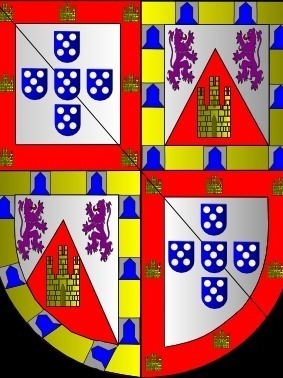 | ||||||||||||||||||||||||||||||||||||||||||||||||||||||||||||||||||||||
(1) ± 1378 | ||||||||||||||||||||||||||||||||||||||||||||||||||||||||||||||||||||||
(2) | ||||||||||||||||||||||||||||||||||||||||||||||||||||||||||||||||||||||
(3) | ||||||||||||||||||||||||||||||||||||||||||||||||||||||||||||||||||||||
Parenté Count Alfonso / Afonso Enríquez / Henriques Count of Gijón and Noreña (asturias) (Count Alfonso / Afonso Enríquez / Henriques, Count of Gijón and Noreña (asturias)) Enríquez de Castilla
- Count Alfonso / Afonso Enríquez / Henriques Count of Gijón and Noreña (asturias) Enríquez de Castilla est le arrière(x19)-petit-fils de Emperor Charlemagne "the great" Charles the Great Charles I King of the Franks (768+) King of the Lombards (774+) Emperor of the Romans (800/814) /814):Emperor Charlemagne "the great" Charles the Great Charles I King of the Franks (768+) King of the Lombards (774+) Emperor of the Romans (800/814) /814)King Pippin Carloman King Of Italy of ItalyKing Bernard. King of Italy (Carolingean House)Count Seigneur Pépin de Peronne Count of Peronne and St. Quentin in the Vermandois (Carolingean House)Count Herbert / Heribert I Count of Senlis and Vermandois (Carolingean House)Queen Béatrice of Vermandois (Carolingian House) Queen Consort of Western Francia De'Vermandois (Queen of Western Francia)Duke Hughes "the Great" Duke of the Franks and Count of Paris.(House Capet) capetKing Hugh / Hugo Capet King of France (House Capet) CapetKing Robert II "the Pious" King of Franks CapetDuke Robert I 'the old' / "Tete-Hardi" Duke of Bourgogne / Burgundy (House Capet) Bourgogne (Capet)Constance de BourgogneUrraca (Hourse Jimenez) "The Reckless", Queen Regnant of León, Castile, and GaliciaKing Alfonso VII Alfonso Raimúndez "the Emperor" King of Galicia(1111+) King of León and Castile (+1126). Emperor of all Spain, House of IvreaKing Ferdinand II King of León and GaliciaKing Alfonso IX "The Slobberer" King of León & Galicia (House Anscarid)King Ferdinand III (Fernando) "the saint" King of Castile León and GaliciaKing Alfonso X ( Afonso Alphonso Alphonse or Alfons ) "The Wise" King of Castile León and GaliciaKing Sancho IV "The Brave" King of Castile Leon and Galicia (house Bourgogne)King Ferdinand IV (Fernando) "the Summoned" King of Castile León and GaliciaKing Alfonso XI ( Afonso ) "the avenger" king of Castile León and Galicia (Bourgogne)King Enrique II ( Henri II ) "the fratricidal" King of Castile (Trastámara)Count Alfonso / Afonso Enríquez / Henriques Count of Gijón and Noreña (asturias) Enríquez de Castilla
- Count Alfonso / Afonso Enríquez / Henriques Count of Gijón and Noreña (asturias) Enríquez de Castilla est le arrière(x12)-petit-fils de King Hugh / Hugo Capet King of France (House Capet) Capet:King Hugh / Hugo Capet King of France (House Capet) CapetKing Robert II "the Pious" King of Franks CapetDuke Robert I 'the old' / "Tete-Hardi" Duke of Bourgogne / Burgundy (House Capet) Bourgogne (Capet)Constance de BourgogneUrraca (Hourse Jimenez) "The Reckless", Queen Regnant of León, Castile, and GaliciaKing Alfonso VII Alfonso Raimúndez "the Emperor" King of Galicia(1111+) King of León and Castile (+1126). Emperor of all Spain, House of IvreaKing Ferdinand II King of León and GaliciaKing Alfonso IX "The Slobberer" King of León & Galicia (House Anscarid)King Ferdinand III (Fernando) "the saint" King of Castile León and GaliciaKing Alfonso X ( Afonso Alphonso Alphonse or Alfons ) "The Wise" King of Castile León and GaliciaKing Sancho IV "The Brave" King of Castile Leon and Galicia (house Bourgogne)King Ferdinand IV (Fernando) "the Summoned" King of Castile León and GaliciaKing Alfonso XI ( Afonso ) "the avenger" king of Castile León and Galicia (Bourgogne)King Enrique II ( Henri II ) "the fratricidal" King of Castile (Trastámara)Count Alfonso / Afonso Enríquez / Henriques Count of Gijón and Noreña (asturias) Enríquez de Castilla
- Count Alfonso / Afonso Enríquez / Henriques Count of Gijón and Noreña (asturias) Enríquez de Castilla est le arrière(x25)-petit-fils de King Ceolwald King of Wessex of Wessex:King Ceolwald King of Wessex of WessexCoenred of Wessex (Wessex)Ingild of Wessex (Wessex)Eoppa King of Wessex of WessexEafa King of Wessex of WessexKing EALHMUND King of Wessex of Kent (Wessex)Egbert King of Wessex (802-839) ( Ecgberht / Ecgbert / Ecgbriht ) of WessexAethelwulf King of Wessex (839-858) King of WessexAlfred The Great King of Wessex (871-899) of WessexKing Edward "The Elder",King of the Anglo-Saxons (899-924) King of the Anglo-SaxonsKing Edmund I King of England (939-946),"the Deed-doer" the "Just" or "the Magnificent" of EnglandKing Edgar the Peaceful King of England of EnglandKing Ethelred II "'the Unready' King of England (978 – 1013) and (1014-1016) of EnglandKing Edmund II 'Ironside' King of England (1016) AthelingEdward 'Edward the Exile' AthelingMargaret CeannmoreEadgith Edith of ScotlandMatilda (Maud) "Holy Roman Empress Lady of the English" de Anjou, of NormandieHenry (Henry II) "King of England Curtmantle FitzEmpress" House of PlantagenetEleanor of england of Castile daughter of Eleanor of Aquitaine House of PlantagenetBerengaria Queen Regnant Castile & Queen Consort Infanta of Castile de CastillaKing Ferdinand III (Fernando) "the saint" King of Castile León and GaliciaKing Alfonso X ( Afonso Alphonso Alphonse or Alfons ) "The Wise" King of Castile León and GaliciaKing Sancho IV "The Brave" King of Castile Leon and Galicia (house Bourgogne)King Ferdinand IV (Fernando) "the Summoned" King of Castile León and GaliciaKing Alfonso XI ( Afonso ) "the avenger" king of Castile León and Galicia (Bourgogne)King Enrique II ( Henri II ) "the fratricidal" King of Castile (Trastámara)Count Alfonso / Afonso Enríquez / Henriques Count of Gijón and Noreña (asturias) Enríquez de Castilla
- Count Alfonso / Afonso Enríquez / Henriques Count of Gijón and Noreña (asturias) Enríquez de Castilla est le arrière(x14)-petit-fils de Duke Rolf (Rollo) "The Ganger" 1st Duke of Normandy /Hrólfsdóttir Ragnvaldsson:Duke Rolf (Rollo) "The Ganger" 1st Duke of Normandy /Hrólfsdóttir RagnvaldssonGeirlaug (Gerloc) Hrólfsdóttir (from Normandy) HrólfsdóttirAdelais de AquitaineKing Robert II "the Pious" King of Franks CapetDuke Robert I 'the old' / "Tete-Hardi" Duke of Bourgogne / Burgundy (House Capet) Bourgogne (Capet)Constance de BourgogneUrraca (Hourse Jimenez) "The Reckless", Queen Regnant of León, Castile, and GaliciaKing Alfonso VII Alfonso Raimúndez "the Emperor" King of Galicia(1111+) King of León and Castile (+1126). Emperor of all Spain, House of IvreaKing Ferdinand II King of León and GaliciaKing Alfonso IX "The Slobberer" King of León & Galicia (House Anscarid)King Ferdinand III (Fernando) "the saint" King of Castile León and GaliciaKing Alfonso X ( Afonso Alphonso Alphonse or Alfons ) "The Wise" King of Castile León and GaliciaKing Sancho IV "The Brave" King of Castile Leon and Galicia (house Bourgogne)King Ferdinand IV (Fernando) "the Summoned" King of Castile León and GaliciaKing Alfonso XI ( Afonso ) "the avenger" king of Castile León and Galicia (Bourgogne)King Enrique II ( Henri II ) "the fratricidal" King of Castile (Trastámara)Count Alfonso / Afonso Enríquez / Henriques Count of Gijón and Noreña (asturias) Enríquez de Castilla
- Count Alfonso / Afonso Enríquez / Henriques Count of Gijón and Noreña (asturias) Enríquez de Castilla est le arrière(x18)-petit-fils de Gregor (Kenneth I) "Giric Cináed mac Ailpín King of Picts of Scotland (MacAlpin):Gregor (Kenneth I) "Giric Cináed mac Ailpín King of Picts of Scotland (MacAlpin)King Constantine "Causantin mac Cináeda" King of Picts of Scotland (MacAlpin)King Domnall mac Causantín (Donald II) King of Picts "Domnall the Madman of Scotland (MacAlpin)King Malcolm "Mael Coluim King of Alba" of Scotland (MacAlpin)King Kenneth mac Máel Coluim (Kenneth II) "Cináed King of Alba" of Scotland (MacAlpin)King Malcolm II Mael Coluim King of Scotland "The Destroyer" Canmore House of Alpin aka Clann Chinaeda meic Ailpín Kings of the Picts of Scotland (MacAlpin)Bethóc of ScotlandKing Duncan I "Donnchad mac Crínáin King of Strathclyde King of the Scots" of Scotland (Dunkeld)King Malcolm III "Canmore Ceannmore King of the Scots King of Cumbrians Maol Chaluim mac Dhonnchaidh" of Scotland formerly Dunkeld aka MacDuff Ceannmore (Dunkeld)Eadgith Edith of ScotlandMatilda (Maud) "Holy Roman Empress Lady of the English" de Anjou, of NormandieHenry (Henry II) "King of England Curtmantle FitzEmpress" House of PlantagenetEleanor of england of Castile daughter of Eleanor of Aquitaine House of PlantagenetBerengaria Queen Regnant Castile & Queen Consort Infanta of Castile de CastillaKing Ferdinand III (Fernando) "the saint" King of Castile León and GaliciaKing Alfonso X ( Afonso Alphonso Alphonse or Alfons ) "The Wise" King of Castile León and GaliciaKing Sancho IV "The Brave" King of Castile Leon and Galicia (house Bourgogne)King Ferdinand IV (Fernando) "the Summoned" King of Castile León and GaliciaKing Alfonso XI ( Afonso ) "the avenger" king of Castile León and Galicia (Bourgogne)King Enrique II ( Henri II ) "the fratricidal" King of Castile (Trastámara)Count Alfonso / Afonso Enríquez / Henriques Count of Gijón and Noreña (asturias) Enríquez de Castilla
Les sources
- de Souza Silva Web Site, Carlos Fernando de Souza Silva, via https://www.myheritage.com.br/person-150...
Adicionado confirmando um Smart Match
MyHeritage family tree Family site: de Souza Silva Web Site Family tree: 439501431-1
- WikiTree, via https://www.wikitree.com/wiki/Enr%C3%ADq...
Profile of him on wikitree
www.wikitree.com
Même jour de naissance/décès
- 1277 » Marguerite de Bourgogne, vicomtesse de Limoges.
- 1312 » Arthur II, duc de Bretagne (° 25 juillet 1261).
- 1372 » Philippe de Cabassolle, prélat français (° 1305).
- 1521 » Josquin Desprez, compositeur français (° 1450).
- 1576 » Titien (Tiziano Vecellio, dit), peintre vénitien (° 1488).
- 1590 » Sixte V (Felice Peretti, dit), 227pape, en fonction de 1585 à 1590 (° 13 décembre 1520).
Sur le nom de famille Enríquez de Castilla
- Afficher les informations que Genealogie Online a concernant le patronyme Enríquez de Castilla.
- Afficher des informations sur Enríquez de Castilla sur le site Archives Ouvertes.
- Trouvez dans le registre Wie (onder)zoekt wie? qui recherche le nom de famille Enríquez de Castilla.
Carlos Fernando de Souza Silva Brogni, "Family Tree of Carlos Spartacus.", base de données, Généalogie Online (https://www.genealogieonline.nl/family-tree-of-carlos-fernando-de-souza-silva/I501900.php : consultée 15 mai 2024), "Count Alfonso / Afonso Enríquez / Henriques Count of Gijón and Noreña (asturias) (Count Alfonso / Afonso Enríquez / Henriques, Count of Gijón and Noreña (asturias)) Enríquez de Castilla (1355-1395)".
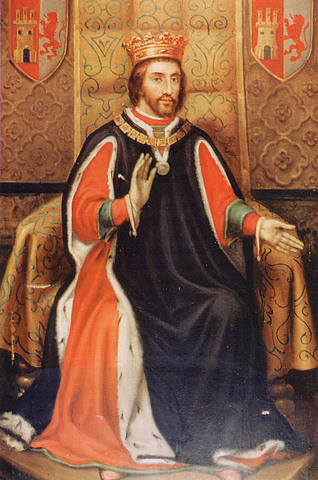
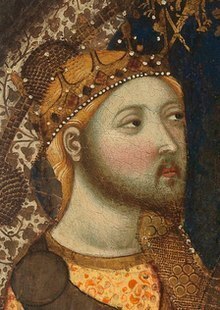
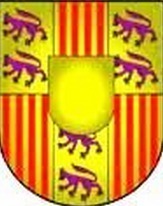
![Count Sancho de Noronha first Count of Odemira,[1][2] comendador mayor of the Order of Santiago alcalde-mor of Estremoz and Elvas Lord of Vimieiro Mortágua Aveiro and other territories de Noronha, 1º conde de Odemira](https://static.genealogieonline.nl/img/go/13012/thumbs/e_x_t_b294d14908ae6bcf2dd818f5e93d364c.jpg)
